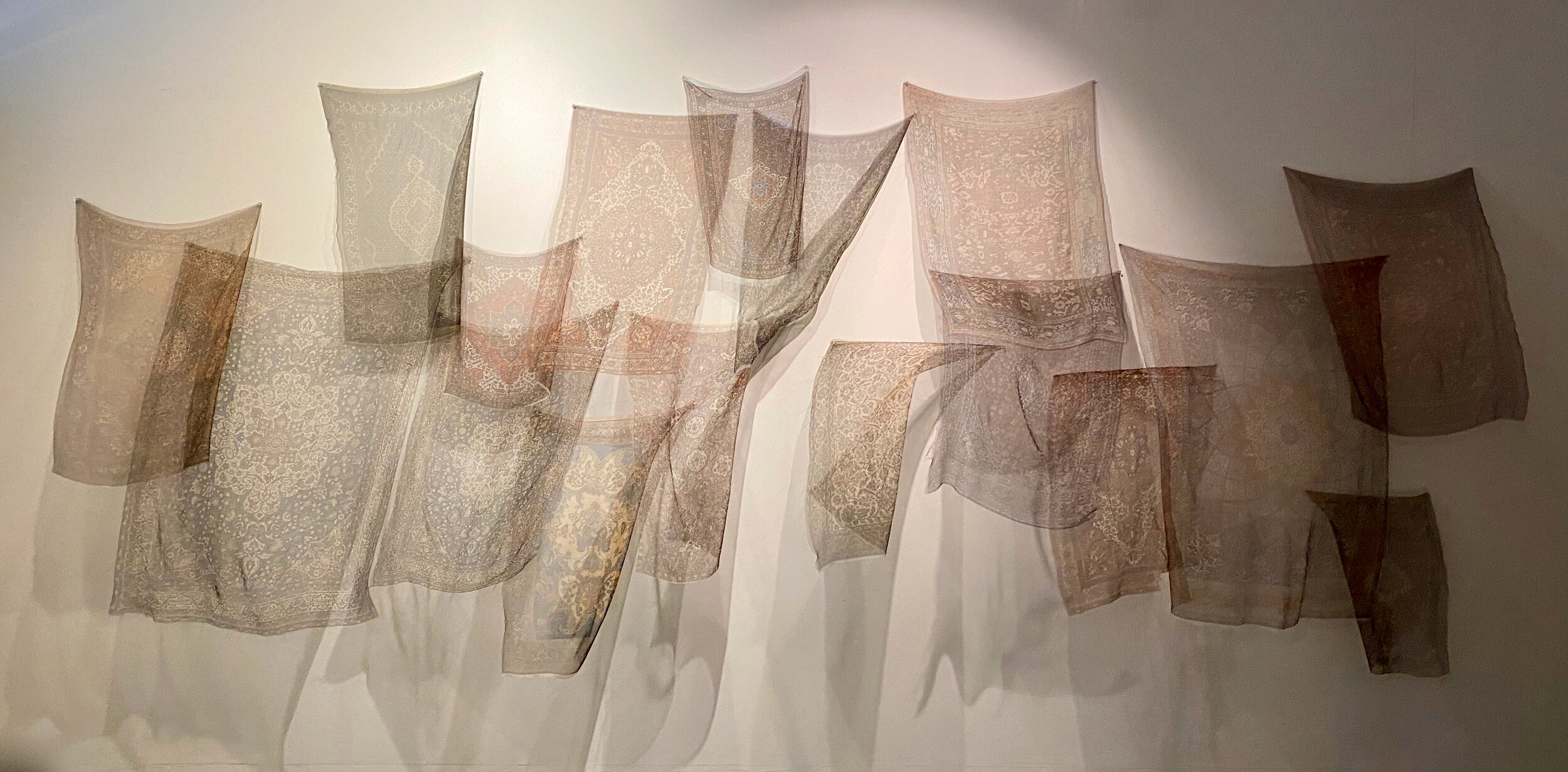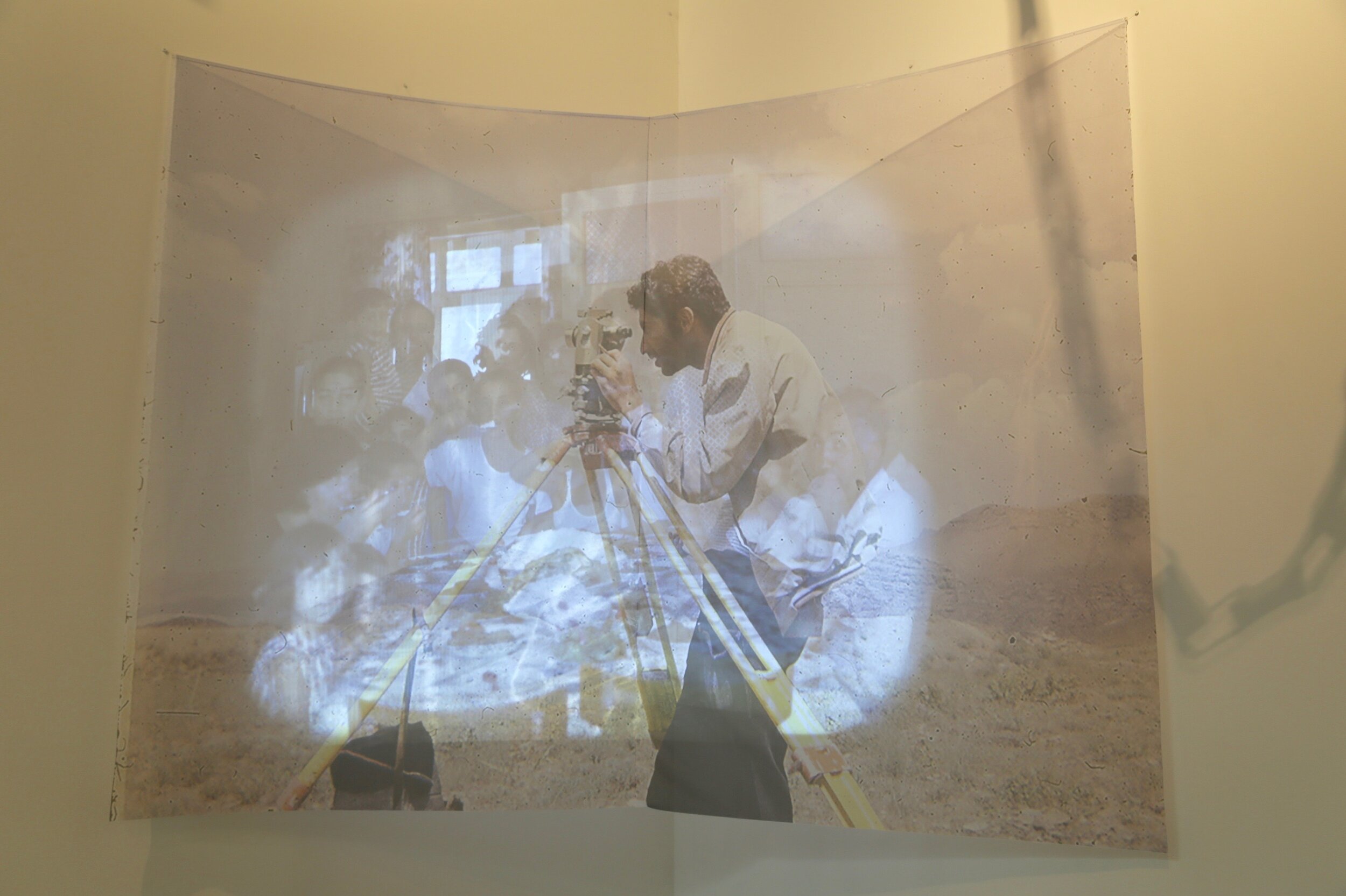Shirin Towfiq
Shirin Towfiq explores intergenerational communication in the context of a specifically Iranian-American experience. Through collaborating with her family members on projects by translating their memories into visual works she playfully reimagines boundaries, migration, movement, (dis)comfort, embodied archives, and home.
In recent years, Towfiq presented a solo-exhibition at the Hill Street Country Club, Oceanside, CA and has been included in group exhibitions at Minnesota Street Project, San Francisco; SomArts, San Francisco; San Francisco State University Fine Arts Gallery; c3artspace, Melbourne, Australia. Shirin Towfiq has won various awards, such as the Murphy award in 2020, and the Curator’s Choice award from the Museum of Contemporary Art San Diego in 2017. She completed a Bachelor of Arts in Art Practice from the University of California Berkeley in 2016 and a Masters of Fine Arts from Stanford University in 2020.
Two Atoms (from above)
Two Atoms (from above), 2019, video

Pencil Broom

Broom for Two

Moved
Moved, 2019, video

Thinking About Migration
Thinking About Migration, 2020, 15’ x 10’ installation of 20 digital prints on gauze with fan

Remnant

All Mysteries Are Now Unveiled

I Want To Go Home (translated from Persian)

No, I Never Want To Go Back
Q & A between Karla Centeno &
Shirin Towfig
KC: When did you first start creating art? Was it an early interest for you?
ST: Growing up I knew that I was creative and liked making things with my hands but I had no idea what art really was. Basically, I had no interest in art since anything I had ever been shown was european classic art history. I had never seen anyone like me making art and I thought it wasn’t for someone like me growing up.
My parents are refugees from Iran and it wasn’t high on their priority list to take me to galleries or museums or view art, I think their main goal was for me to become a doctor like many immigrant parents.
When I started college I had absolutely no idea what I wanted to do or why I was in college. What really changed everything for me was during the next summer I had an internship in Ukraine, and while I was working a terribly boring office job I realized I couldn’t sit at a desk all day and wanted to be working with my hands somehow.
The people I was working with took me to the Ukraine Biennial which was full of amazing contemporary art installations and videos. Upon seeing the art there I felt like I understood everything on some level and that all the art was in dialogue with something going on in the world. I honestly couldn’t believe that there were people that were doing this for their livelihood and it all felt so important. All I knew was that this was someone’s job and I had to have it!
When I came home from Ukraine I signed up for an installation art class and fell in love with what I was learning and was exposed to conceptual art. During that time I was introduced to more artists and I realized how intelligent, interesting, up to date on current events they were while following their passion and exposing truths.
I knew that I wanted to do something with my hands and be in a position that I would be forced to learn and grow my entire life.
KC: You mentioned in our conversation that you have never really shown artworks in your Ritual Movement collection, why? What is Ritual Movement to you?
ST: Ritual Movement is an instagram account that I started of video experiments where I started thinking about the way I move through the world and what that means. I made rules around the account for a period of time that I had to make one performance video each day, no matter what it was, it could be 10 seconds, 1 hour, whatever! This method of experimentation opened me up and allowed me to understand my interests in new ways, to start thinking about what has been passed down to me through an embodied archive, why do I do the things I do, how I move through each day and what that means.
KC: Do you dream of Iran? If you do, how does Iran manifest in your dreams?
ST: I feel like I dream of Iran on a daily basis, wondering often what the old Iran is like from my family's stories rather than the Iran that exists now on the news. I dream of the architecture, the people, the smells, the typography, traveling through the land. Sometimes when I go for drives through California I wonder if the desert mountains I see in the distance are the same as Iran and collect pictures of them to try to recreate those dreams. I imagine that there must be some similarity between Iran and the California desert and mountains since Southern California has the largest population of Iranians outside of Iran. Maybe they were looking for something which seemed like home.
KC: Most of your artwork revolves around your family, their memories and histories. How does your family respond to your artwork when they see it?
ST: I think they are surprised when they see my artwork now. Growing up I didn’t really care about understanding where my family came from. I only cared about assimilating and what I thought being American was. I didn’t know any other Iranian children growing up. At some point I realized that I would never be able to escape being Iranian, or the child of immigrants. When I went to college I decided to take an intensive Persian language class to reclaim the language I once had lost. My family sometimes asks why I use them so much in my artwork, but to me they are my only access point to Iran and that familial history even if it’s theatracized and reimagined. It’s important to me that someway refugee stories are being remembered and through me trying to understand them that there is another access point to these histories for other people like me.
KC: If you had to leave the U.S. and bring one object with you, what object would you bring with you and why?
ST: When you mention having to leave a country I imagine my family members having to leave Iran quickly to save their lives. I have interviewed different family members on what they took with them the day they left Iran. I have asked myself this question over and over again for the past few years, what would I take with me if I was put in the same situation. I wonder what the conditions would be that would determine what I would take that day. At some point I thought about the triviality of the physical objects around me and what’s really important would just be staying alive. When you’re at the point of desperation physical objects no longer mean as much.
If I had to think again about what I would take if I was put in that position, I think I would take the jewelry that has been passed down from my grandmother that she designed for the royal family and smuggled through the border, and some kind of objects that would bring me comfort. I am a very nostalgic person and love to look at photographs. Maybe something that was a document of a piece of my life, a picture of my family. And a little money to be able to find my way wherever I land.


















